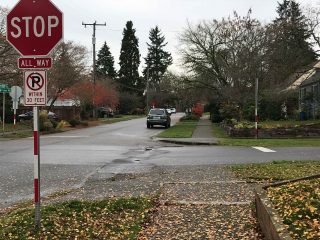
(Photos: Mike Dowd)
This post was written by reader Mike Dowd.
When I grew up in Seattle, stop signs had wood posts with red-and-white, candy cane-like stripes. Now they have metal poles, but they’re still striped. When I moved to Portland, I really missed them! It seemed dangerous without them.
When you approach an intersection in Seattle, the stripes immediately show you whether people entering the intersection from other directions must stop. In Portland, you have to look for the octagonal sign shape — not easy to see when you’re looking at the back of a sign across the intersection (maybe with a telephone or light pole in front of it), and almost impossible when looking at the narrow edge of a sign regulating cross traffic.
It’s critical for everyone — whether driving, riding, or walking — to know who must stop at an intersection. You don’t want to enter an intersection until you’re sure nobody is entering it from your left or right. You don’t want to make a left turn until you know whether an oncoming vehicle or bike is going to stop.
If you misread the intersection, and proceed thinking that crossing traffic has stop signs when it does not, you may cause a crash. If you don’t see others’ stop signs, and slow or stop thinking they don’t need to stop, you create confusion and delays. (Portland has become infamous for the “You go,” “No you go,” “No you go,” dance.)
Advertisement
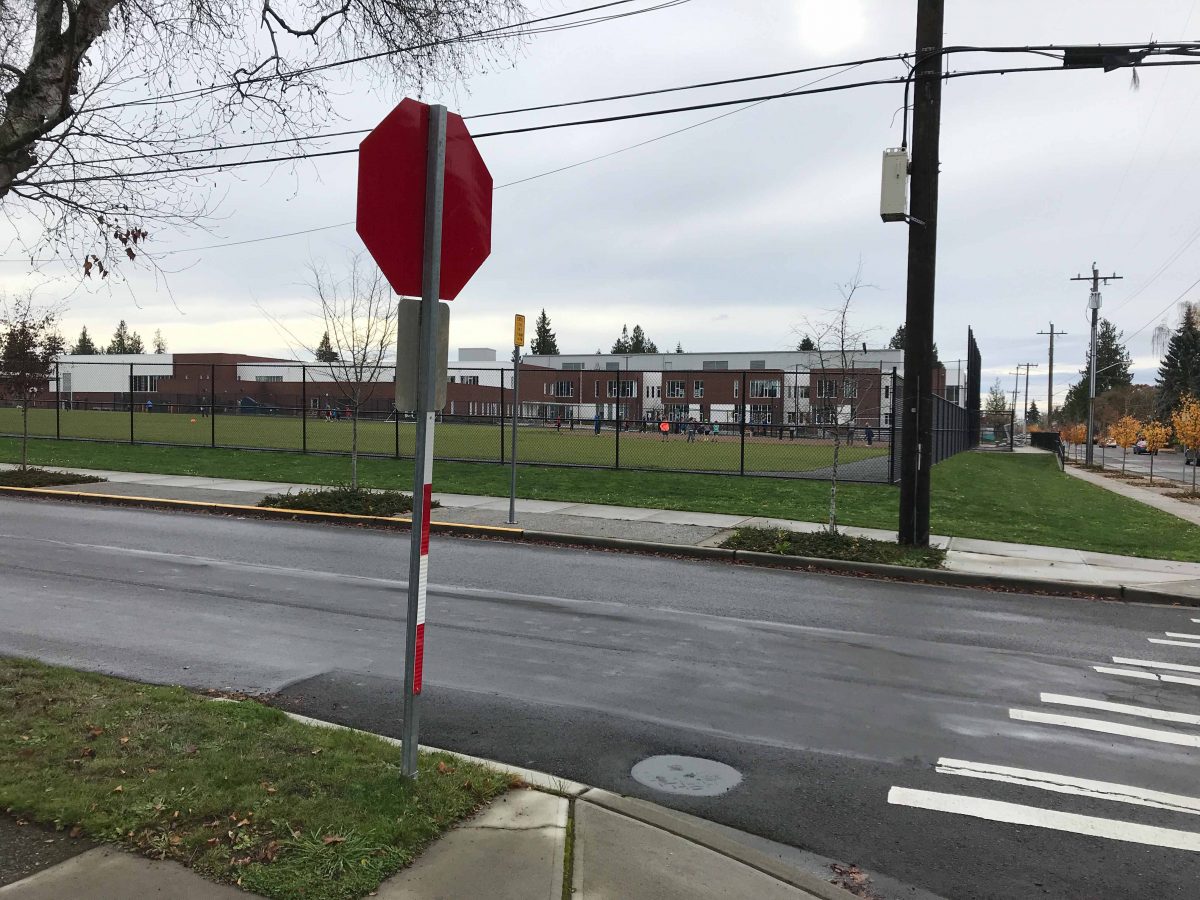
Portland has a mish-mash of info added below stop signs: “All Way” signs at intersections with four stop signs, “Oncoming Traffic Does Not Stop”, “Traffic From Right Does Not Stop”, etc. But it’s not consistent, which itself creates danger. Those also only give information to people who do have a stop sign. If you don’t have a stop sign, there’s no sign telling you whether cross-traffic or oncoming traffic has stop signs.
The stripes also make stop signs much more visible for people approaching them, since the overall “sign” becomes effectively about eight feet tall instead of just a two-foot octagon.
Also, the stripes Seattle adds to metal stop sign posts are reflective, so all the various advantages of the stripes are magnified at night. In Portland, the backs and edges of stop signs are almost invisible at night.
I’d like to see the stripes added in Portland. I’m curious what others have seen in other places.
— Mike Dowd
Never miss a story. Sign-up for the daily BP Headlines email.
BikePortland needs your support.

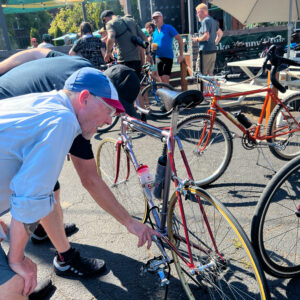
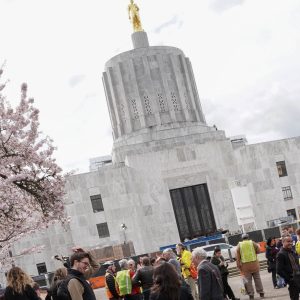
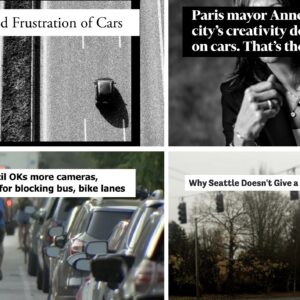
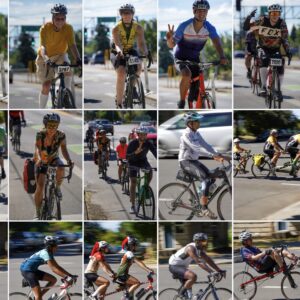
Thanks for reading.
BikePortland has served this community with independent community journalism since 2005. We rely on subscriptions from readers like you to survive. Your financial support is vital in keeping this valuable resource alive and well.
Please subscribe today to strengthen and expand our work.
Are these still useful when a Jeep Cherokee or lifted Chevy pickup are parked right up to the corner, obscuring the entire sign pole and most of the sign itself?
As a violation of city code (16.20) vehicles over 6 feet parked within 50 feet of an intersection can be cited. Contact parking enforcement 503-823-5195.
Instructions: https://www.portlandoregon.gov/transportation/article/369564
A violation of the city code that is NOT enforced. Time for another stop sign enforcement action in Ladd’s Addition. /s/
Any evidence to support your opinion?
It has to be called in to parking enforcement.
hahahahahahahahahahhahahahah…..hahhhhhhh…
[wipes eye]
Thanks for the laugh!
Parking violations are like cigarette butts thrown on the ground; an “acceptable” violation that almost nobody looks twice at. Especially if bad/illegal parking only endangers pedestrians or bicyclists.
Anyone having a hard time seeing a stop sign should contact 823-SAFE.
They are extremely understaffed. They return calls within 5-6 weeks 🙁 it’s almost useless to call
Agreed. I’ve registered several complaints. One even took 6 months to respond! Even then, the staffer used wrong information to reach his conclusion that nothing needed to be done.
I’d have to report ALL of the stop signs in Portland. They’re all hard to see from the side, given that all you see is an edge about 1/8″ thick. You can identify a stop sign with the striped pole from the side from 100 yards away.
What do you think of the stripes?
I WANT THEM
The City should install the signs where they can be clearly seen. Adding these reflective stripes seems like a great idea. I would also really like to see the stop bars painted, at least at cross streets along greenways.
It’s far to common to see the city install a new sign that is being directly blocked by another sign or by vegetation. When you call and ask them why they put the sign in that area and not remove the branch they say “well, that someone else’s job to cut a branch back.” Wtf? Safety third.
And if you complain about vegetation, it depends on whether the vegetation is in the planting strip between the curb and sidewalk or from the tree on someone’s property (behind the sidewalk.) The City that Works. Ha.
I do recall a business being squid over a stop sign that someone ran because it was engulfed by a tree. Wonder if home owners should be held accountable in this manner?
Really?
https://www.portlandoregon.gov/Transportation/article/319702
This is so simple, yet brilliant. I think about the issue of knowing whether other must stop often, but I didn’t think of (and not familiar with) such a simple solution. Things like stop bars on the road are inconsistent and/or worn off. This is great.
If it’s obvious, easy, inexpensive, Portland (Oregon) won’t do it for fear of backlash from some special interest. Nice idea. Fugetabaudit.
Each stop bar is about $50. 5,000 would cost $250,000.
I think people were talking about the stripes on the posts.
That is interesting about the stop bars on the pavement. That doesn’t seem expensive. The stripes on posts don’t seem like they’d be expensive, either, plus there’s no wear on them as there is on pavement markings.
I’ve only seen the stripes on the posts of the post-mounted signs. I don’t remember if Seattle mounts stop signs on telephone poles, but if they do they do, there are no accompanying stripes. And you’re right, stop signs on telephone poles are almost impossible to see from anywhere but the front approach.
IMO, Seattle has way too many stop signs. Parts of Portland does too. When there’s too many, motorists are more likely to ignore them, treat then like Yield signs (which Portland and Seattle have too few of.)
Seattle has a “No Parking within 30 Feet” law at stop signs. IIRC, every stop sign has a no parking sign below it (see Mike’s photos). And they DO enforce!!!
Maybe the parking enforcement is part of Berkeley’s relative success in getting people out of cars. Less than 40% of workers who live in Berkeley are driving to work and about 8% are on bikes, compared to PDX at over 65% in cars and around 6% on bikes. People may not be as willing to get in the car and drive off when they are unsure of both finding parking at their destination and finding a space when they return.
Portland’s 200 ft. blocks might have something to do with unwillingness to give up a couple parking spaces. We have a law against parking a vehicle over 72″ tall at a corner, but it’s not enforced consistently. Basically it doesn’t exist.
Very cool: helpful and safe.
The only problem is that most drivers in Seattle stop about eight feet past the stop sign and nose out into the roadway.. It’s nice that the signs are visible while being ignored though!
Seattle used to be a “No, you go” city but that population has been mostly replaced by transplants who have brought their aggro carhead culture along with them, and while parking enforcement is reliable there is generally no enforcement of moving violations.
All true. But that’s also when the stripes are also especially helpful. The fact that people often don’t stop until they’re past the sign (in Portland too) means you can’t assume there’s NO stop sign for them based on the fact they just drove past the sign. With the stripes, you know they’ve got a stop sign so you know they’ll likely stop a few feet past it. And if you don’t see stripes, you can assume they won’t eventually be stopping, so you can proceed (or not) accordingly.
Guess it’s time for more traffic enforcement action on SE Ladd.
How do you know they’ll stop?
Seriously.
Good point. You also can’t trust ‘them’ not to turn up a one-way street, or into the wrong lane on a 2-way, or do 50 in a 20. However, if ‘they’ are on an e-bike they will hardly ever do 50 in a 20.
“Seriously”? Why the sarcasm?
And I didn’t even say I knew they’d stop. I said “you know they’ll LIKELY stop”, which is a perfectly reasonable thing to say, given that most people do stop at stop signs. Hardly something to mock me for saying.
I’d still like to hear your opinion about the stripes on the posts.
I also find it helpful when a STOP bar is marked on the paving. That helps point folks to a STOP sign alongside the road in case a car is parked too close. Sadly, even these are missing at most neighborhood intersections in Portland. It took two collisions before PBOT installed a two-way STOP control at a relatively busy intersection in my neighborhood where there’s cut through traffic, despite letters and emails from several neighbors both before and after the first collision.
Portland used to have them at all stop signs, but it got too costly to maintain the striping, so they often eliminated the lines but kept the signs.
Joe,
Stop signs don’t prevent all types of crashes, and they can increase rear-end crashes.
There are very clear standards for when stop signs are installed:
https://www.portlandoregon.gov/transportation/article/594876
This strikes me as the kind of information championed by the NMA. Are you saying that intersections with stop signs are safer than intersections without them? And does this logic apply to the surrounding roads?
Unfortunately so many are worn invisible due to drivers stopping on or over them. They are usually in advance of the sidewalks, where they should be, but drivers don’t stop and advance, they tend to stop at the street’s edge (while looking left for oncoming traffic, not to the right for pedestrians first).
Many decades ago I was taught to drive. It was actually a course taught in high schools by certified instructors. One of the early lessons that was drilled into every student’s head until it practically dripped out was, “Identify the intersection as you approach.” That means to actively look for traffic control devices for traffic coming from all directions. If you wait until you arrive, you’re too late and may not be able to see the signs/lines/lights.
A couple decades later, I went and got a CDL so I could drive tomato trucks. (I did this “drive a mile in their seat” to learn why they were such jerks on the road.) Guess what one of the earliest and most often repeated lessons was? Right, “Identify the intersection as you approach.”
Sadly, we’re now several decades removed from the days when people were taught to drive by professionals, and it shows. Sure, we can put reflective stripes on stop signs and lay down the limit lines and do all sorts of other things that make sense, but in the end the problem is that our motorists are so poorly trained by other poorly trained motorists. All the reflectors, signs and thermoplastic in the world won’t fix that.
You nailed it. How many of us have been in a car when the driver DOESN’T give the car on the right the right of way and when you ask why they say because the driver on the right is supposed to give me the right of way, or some weird version of that story…
Is that true? I know lots of fairly new drivers, and they all took driver’s ed. I also notice bad drivers of all ages, and don’t think the younger ones are any worse than older ones, or at least not worse than the older ones were when THEY were younger.
I agree poorly trained drivers are a big problem, and that things like the stripes won’t change that. On the other hand, they’re not the ONLY problem. And if your instructors were correct that “identifying the intersection as you approach” is important, then the stripes are a great thing, because they make that important task much easier. That goes for the many poor drivers, too–and anything that makes poor drivers safer drivers is good.
What we’re taught and what we innately do are usually different. I was taught that if at any time a kid or dog ran out in front of you that you should be able to stop, so that you needed to be going very slow in very dense areas or it was your fault for not driving for the conditions. But instead culture taught us that might makes right and that it’s not our fault when kids and dogs dart in front of us and get hit.
It took a long time for me to get back to what I was taught. Culture is not easy to overcome.
Do it, Portland!
The term is “STOP BAR” as to what that strip on the roadway is. And all stop signs without marked crosswalks should have them.
I live in a city that actually carries that out that policy to the letter, but our drivers are no better than yours, they still don’t bother to stop, certainly not before that line, and they certainly don’t yield to pedestrians.
White & red retroreflective stickers cost $8 – $12 for a pack of 4. Since they’re 18″ long, two would be sufficient per stop sign. You can even split them down the middle to get more coverage. This means that a single 4 way stop intersection can be outfitted this way for about ten bucks. Nothing is stopping anyone from doing this.
Do the intersections on your commute first.
Well, it would be illegal…
Why? Is it not MUTCD approved? If Seattle can do it then why not us?
I was reading the comment as suggesting people do it on their own, which would be illegal, inconsistent, etc. I could be wrong about interpreting it that way, though. I totally support the City doing it.
I went to school at the UW and lived for years there and bike commuted from the U Dist to downtown and then later from the U Dist to Sand Point on the Burke Gillman. And I don’t ever remember noticing this about the stop signs. Sheesh. You learn something new every day.
I’ll also endorse installing stop bars at ALL stop signs. Of course some jurisdictions on the west coast not only have stop bars, but also the word “STOP” painted on the street. When driving there, I tend to look at the roadway, as the markings on the road are easier to see than the sometimes hidden stop sign.
But yes, the reflective red/white stripes on the poles too, which also won’t need repainting. If the signs on a power pole, place those strips on all sides of the power pole (which of course will need a new agreement with the pole owners!)
Let’s do this! I think we’ve played out the green paint already.
The World would be a better place without stop signs.
Maybe I’m crazy but there are three options. 1. Stop sign on your approach with “All Way” placard = All way stop control. 2. Stop sign on your approach without placard = Two way stop control. 3. Stop sign on your approach with lots of other sign clutter = read to figure out why it’s not a two way or all way stop.
I agree those signs under the stop sign are helpful (and you can see the “all way” sign in the photo).
One thing the pole stripes do that signs under the stop sign don’t achieve is that they give information to someone approaching an intersection who does NOT have a stop sign themselves. They show you instantly if any of the other three approaches have to stop. It’s the equivalent of “cross traffic stops” or “cross traffic does not stop” signs, with the pole stripes solving the fact that if you don’t have a stop sign yourself, there’s no place for signage that tells you whether the other approaches have to stop or not.
4. Stop sign not on your approach so you don’t see any of signs and don’t know that cross traffic has signs.
Mike —
I’m a little fuzzy on this.
Are you talking about just seeing stop signs that might be hidden by tree branches? Or telling whether an intersection is stop-controlled vs no signs at all (“uncontrolled”)
Uncontrolled intersections are quite dangerous, in my opinion. Particularly if you’re driving or bicycling through an unfamiliar neighborhood, and you don’t know if upcoming intersections are controlled or not. For instance, going north on Rodney Ave in Portland the stop signs ended at Ainsworth. So north of Ainsworth each intersection had no stop signs at all, uncontrolled, and if two vehicles approach at the same time and assume the other one has a stop sign, you get a major crash. (90 degree hits at 20 mph).
There’s still lots of sectors of Portland with uncontrolled intersections. Like north of Fremont and west of 57th. Or Missouri Ave from Fremont to Mason.
It looks like the reflective stripes are on the pole, facing traffic that stops, and away from traffic that stops. But not on the sides facing traffic that don’t stop.
So, if you’re approaching an intersection, and want to know if it’s a controlled intersection or uncontrolled can you see the reflective posts at all? Since the reflectors are aimed 90 degrees away from you?
Just curious.
And still trying to figure out the overall benefit.
Ted Buehler
Or, put another way.
Are you stating that the reflective posts help an “uncontrolled” intersection like this?
https://goo.gl/maps/Re4ZL3GqrG62 N Failing at Missouri
It’s uncontrolled. nobody has a stop sign. If people are approaching on two legs, at 90 degrees to each other, and each assumes the other has a stop sign, then they collide. But, if they both were looking sharp for reflectors on the cross street, then they’d both realize the other didn’t have a stop sign, and approach the intersection like a Yield sign (as per the Oregon Drivers Manual).
Or, are you proposing that the reflectors help in a situation like this, where the view of the stop sign is completely obstructed by trees, so you’d know that you had a stop sign because you’d see the reflective stripes on the stop sign pole for opposing traffic?
https://goo.gl/maps/tQcgTSwEXQq N Failing at Michigan
Just curious,
Ted Buehler
Ted, thanks for these questions.
I’d say the stripes do help some at an uncontrolled intersection. Since it’s uncontrolled, there are no stop signs, so there are no striped posts. But you can see there are no stripes sooner than you can see that there are no stop signs. So people in Seattle are clued in that an intersection is uncontrolled more quickly than people in Portland.
In your second case, where there ARE stop signs, but they’re obscured, the stripes definitely help. Your own stop sign, that you’re approaching, would be identifiable by its striped post even back from where the street view is taken, even though the sign itself is totally obscured. And the sign across the intersection (that you’re seeing the back of) would also be identifiable much more readily than what you see in the street view (which is a gray octagon that disappears into its surroundings). You’d also more readily be able to see that the cross street has no stop signs.
I’m talking about the stripes showing to anyone approaching from any direction whether the intersection is stop-controlled (2, 3 or 4-way) or uncontrolled. The stripes do also help identify a stop sign when vegetation covers the sign itself, but that’s just a side benefit, since that’s not common.
When I grew up in Seattle, the posts were wood, with the stripes painted all the way around, so they were visible from every direction. Since I live here now, I don’t know what the typical practice is with the new metal posts. In my photos, it looks like the striped reflectors are on the front, rear, and street sides, but not the block-side. I’d say all four sides would be ideal, but omitting the block-side one isn’t too bad, since once you’re close to the intersection, you can see the rear (meaning the side that’s the back of the stop sign) well. I don’t know if my photos represent what’s typical, but my guess (from memory and from looking at some google street views) is that it is. The google street view for the intersection where I took the photos has no reflectors, I think because the signs were brand new.
So the answer is yes, as you approach an intersection, the reflectors do allow you to readily identify each stop sign (meaning you also know which drivers or bikes approaching towards you are across your path do NOT have stop signs, which might be the most important benefit).
If it’s front-to-back visibility (vs. side-to-side visibility) then take a look at what Minneapolis does — they paint the back side of each stop sign red. No “STOP” lettering, but it’s red. So you have two red octgons to see on approach, rather than just one.
https://goo.gl/maps/ToANq3MmKqP2
This improves visibility when approaching an intersection if the tree branches or a vehicle are blocking the right-side stop sign.
But, of course, can create a false sense of security if you transition to a place where the backsides aren’t red, and you might breeze through a stop sign and get yourself seriously injured.
Ted Buehler
Yes, the red backs are great. Seattle does that, but apparently not consistently, since the second photo shows a red back , but the first shows a gray back (but there’s a stop sign with a red back barely visible in the background).
There’s an intersection I walk through daily here that LOOKS like there’s a stop sign for oncoming traffic, but it’s actually a “rail crossing ahead” sign. So if you miss (easy to do) that it’s a gray circle and not a gray octagon, you’re tricked into thinking the oncoming traffic will be stopping. If stop sign backs were painted red, you’d be warned quickly that it is not a stop sign.
With stop bars and the word “STOP” on the street, you can easily glance at the side streets and see if they are stop-controlled.
I was in Tigard today, and they have the striped poles everywhere.
I drove through this intersection (as an example) which I was unfamiliar with, and the striped poles immediately show the stop signs to either side, from a distance. The one on the right has a stop bar, but that’s not readily visible from a distance. That stop sign itself would be almost invisible because you’re looking at its edge: https://www.google.com/maps/@45.4098786,-122.7467832,3a,89.9y,188.69h,73.2t/data=!3m6!1e1!3m4!1s4g5AJky87Hsp3qRgrz0ufg!2e0!7i13312!8i6656
Same intersection from another approach–the stripes help the stop signs in the foreground and background show up, and it’s easy to see that there are no stop signs for traffic approaching from left or right, because if there were, their striped poles would be easily visible.
https://www.google.com/maps/@45.4099006,-122.747484,3a,36y,112.19h,88.77t/data=!3m6!1e1!3m4!1stJPlsk081u_98_nbveOknQ!2e0!7i13312!8i6656
Portland exists in an alternate plane of existence. A place where street signs and road markings cannot be trusted, if they are even visible.
The real world reality of this is that instead of taking 5 seconds to assess the situation when you stop at a stop sign, people could take 1 second, look that there are red and white striped poles, then run over the kid riding their bike because all they did was look for the poles.
Are you saying that making stop signs more visible reduces safety?
Since reading this story, I’ve been noticing this, and sadly these stripes are generally not present. I’m gladdened when I do see them, but mostly: just not there.
I was just up in Seattle again recently. They seemed to be on most stop signs in the area I was in, but certainly not all. Interestingly, I also saw quite a few of the old striped wooden poles still hanging in there.
I thought people might be interested in this….I contacted PBOT via facebook several weeks ago and asked who at PBOT to email about this suggestion to add stripes to stop signs. I got an immediate response (thank you PBOT on facebook!) to email the Vision Zero team, with their contact email.
I sent the email almost a month ago. Didn’t even get an acknowledgment that it was received.
I’ll bug them, but geez…
Update: I sent another email to PBOT’s Vision Zero team on January 15th, since I never got a response from them. I got a nice, immediate response saying they’d get back to me that same week. Two weeks later, haven’t heard a thing.
I will try bugging them again.